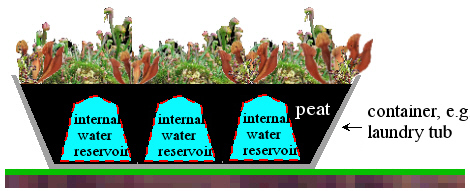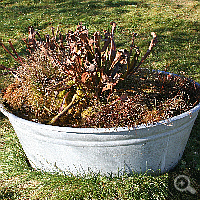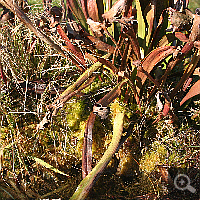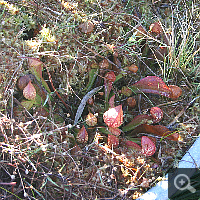Bog pot
Overview
If you have not enough space in your garden for realisation of a great bed or if you have no garden, you have not to spare a longtime functioning raised bog. Realisation succeeds also in a substantial smaller scale. A suitable container is found quickly, a cement tub is likewise suited as a withdrawn, old laundry tub. Sole precondition is watertightness and a minimum volume of circa 40 litres. In this container you can create with little effort a longtime stable raised bog, in which numerous carnivorous plants can be cultivated all-year easily. Such a „mini-bog“ is doubtless an enrichment for each balcony, terrace or front garden.
Construction and care
 As already mentioned, each watertight container is suited, if it features at least circa 40 litres volume and a minimum height of circa 20 centimetres. Fundamentally and as secret of success, namely to create a longtime stable and with little care managing-with bog, is basic construction of the mini-bog (compare adjacent graphic). It is not enough to fill simply the container brimful with soil, because water storage capacity is too low in that case and the bog will dry out from early summer on. In principle artificial bogs are – equally wether it concerns a mini-variant or a large landscape project – rather construct as a pond with a floating peat layer. Because peat sinks, as soon as it is saturated with water, the internal water reservoirs have to be marked out by a stable demarcation from the surrounding peat.
As already mentioned, each watertight container is suited, if it features at least circa 40 litres volume and a minimum height of circa 20 centimetres. Fundamentally and as secret of success, namely to create a longtime stable and with little care managing-with bog, is basic construction of the mini-bog (compare adjacent graphic). It is not enough to fill simply the container brimful with soil, because water storage capacity is too low in that case and the bog will dry out from early summer on. In principle artificial bogs are – equally wether it concerns a mini-variant or a large landscape project – rather construct as a pond with a floating peat layer. Because peat sinks, as soon as it is saturated with water, the internal water reservoirs have to be marked out by a stable demarcation from the surrounding peat.
For construction of the internal water reservoirs normally plastic containers are used, in which all round numerous small holes were drilled, so that a water exchange between internal water reservoir and peat is ensured. Type of plastic containers is determined by the chosen external container. Internal water reservoirs should fill out the external container to the greatest extent and end circa 10 cm below of the top margin of the container. Convenient are for example flowerpots or plastic buckets, which are placed reversed (so with the opening downward) on the bottom of the container. Before numerous holes, circa as thick as a finger, are applied roundabout (also above at the bottom). Subsequently the container is filled halfway through with rainwater or distilled water and the spacings between the internal water reservoirs are tightly filled up with soil. For a raised bog suitable peat is enough alone, where necessary, some lime-free quartz sand can be mixed in, but what is definitely not necessary. Suited peat is exclusive unfertilized, low decomposed raised bog peat. Do not use another peat sort because you will otherwise obtain a disastrously poor result. Peat must, before it is brought in, be mingled well with water, because it floats otherwise. Therefore interstices are filled up to the top margin of the internal water reservoirs with soil and then some water is refilled, if necessary, so that the internal water reservoirs are completely filled with water. Finally the remaining 10 centimetres to the top margin of the container are also filled up with peat and some water is refilled once more.
In plastic containers a drain hole should be drilled circa two centimetres below of the top margin, so that during heavy rainfalls water can drain off. Otherwise soil is filled up circa one to two centimetres above the top margin, so that excess water can simply drain off over the rim. The mini-bog is now so far as it can be shaped and planted. At first you can create different earth hummocks (elevations) and slots, then decorations like a root set in. Then you plant chosen species corresponding their light and moisture demands. Furthermore planting of the peat moss (Sphagnum spec.) is important for the enduring success. This is protected and must not be gathered from nature thus. It is in a few specialised nurseries and partially from other carnivorous plant enthusiasts obtainable. Search for it in the respective fora. Peat is all-year wet. In rainy conditions internal water reservoirs are refilled and during dry periods gradually depleted. By the peat cones water gets by capillary action of the peat to the soil surface. Cones act as a wick thereby. The peat moss maintains in the long term the milieu in your mini-bog. Special pumps secrete protons, wherewith they reduce pH-value and keep the bog „weeds-free“, because only adapted bog plants prosper under these extreme circumstances. To those count among many hardy carnivorous plants and some bog orchids a whole string of further interesting plants.
A special form – the low-moor bog:
Construction of a low-moor bog differs from a raised bog only in the uppermost layer. Instead of pure peat a mixture from peat and a sand-chippings-mixture is used (circa 60:40 mixed). For sand-chippings-mixture fine-grained lime chippings and calcareous sand are mixed circa in equal shares. A low-moor bog is especially because of the numerous non-carnivorous genera and species attractive. As carnivorous plants are hardy butterworts and Drosera linearis suited.
Annual care:
A such designed mini-bog impresses with a markedly low need for care. In early spring old pitchers are pruned. In some circumstances, shortly later the bog must temporary be covered with a net or the like because nesting birds view the bog as construction yard and can partially pick it to pieces severely. Some months later you can possibly cater with the brush for a good seed setting. However, from early summer on it can in the case of hot weather for weeks infrequently happens that the internal water reservoirs must be refilled. That occurs maximal two to three times per annum and is the more improbable the better ratio of the volume of the internal water reservoir to the total volume is. In autumn you should direct your attention to the peat moss. During the cool-wet season this grows gorgeously and threatens sometimes delicate small plants to overgrow. Where necessary, this should be pruned. Generally butterworts and sundews should be planted only on nude peat because they partly have difficulties with the well-growing sphagnum in the long term. Finally, in late autumn frost-sensitive species should be covered with leaves and cut twigs. By the way: A raised bog is never fertilised!
Beside a number of North American pitcher plant-hybrids and some sundew-hybrids are the following pure species for a bog pot all-year suited. The list is not finally.
| genus (botanical) | species (botanical) | English name | annotation |
|---|---|---|---|
| Aldrovanda | vesiculosa | Waterwheel plant | Plant for experts! Requires absolutely clean water. Addition of dried sedge and reed leaves advantageous. |
| Darlingtonia | californica | California pitcher plant | Sensitive. Within peat moss, so that during summer not too hot. Winter protection necessary. |
| Dionaea | muscipula | Venus Flytrap | Conditionally recommended. Only nominatform with winter protection well frost-hardy. |
| Drosera | anglica | English sundew | Absolutely recommended. |
| Drosera | binata | Fork-leaved sundew | Nominatform more or less frost-hardy, the more branched the variants, the more frost-sensitive. |
| Drosera | filiformis | Thread-leaved sundew | Absolutely recommended. |
| Drosera | intermedia | Oblong-leaved sundew | Absolutely recommended, requires a wet location. |
| Drosera | linearis | Slenderleaf sundew | Basic soil! |
| Drosera | rotundifolia | Round-leaved sundew | Absolutely recommended. |
| Pinguicula | alpina | Alpine butterwort | Basic soil! In hot summers somewhat difficult. |
| Pinguicula | grandiflora | Large-flowered butterwort | Basic soil! |
| Pinguicula | vulgaris | Common butterwort | Neutral till basic soil! The easiest butterwort. |
| Sarracenia | alata | Pale pitcher plant | Well frost-hardy. |
| Sarracenia | flava | Yellow pitcher plant | Well frost-hardy. |
| Sarracenia | leucophylla | White pitcher plant | Conditionally frost-hardy. |
| Sarracenia | minor | Hooded pitcher plant | Well frost-hardy. |
| Sarracenia | oreophila | Green pitcher Plant | Very difficult. Summer dormancy. |
| Sarracenia | psittacina | Parrot pitcher plant | Only very conditionally frost-hardy. |
| Sarracenia | purpurea | Purple pitcher plant | Very frost-hardy. |
| Sarracenia | rubra | Sweet pitcher plant | Well frost-hardy. |
| Utricularia | australis | Southern bladderwort | Absolutely recommended. Aquatic. |
| Utricularia | bremii | Small bladderwort | More difficult. Aquatic. |
| Utricularia | cornuta | Horned bladderwort | Absolutely recommended. Terrestrial. |
| Utricularia | intermedia | Flatleaf bladderwort | More difficult. Aquatic. |
| Utricularia | minor | Lesser bladderwort | More difficult. Aquatic. |
| Utricularia | ochroleuca | Yellowishwhite bladderwort | More difficult. Aquatic. |
| Utricularia | purpurea | Eastern purple bladderwort | Aquatic. Low water level. Add sand to the soil. Frost-hardy are only clones from Canada or the Northern USA. |
| Utricularia | stygia | Arctic bladderwort | Absolutely recommended. Aquatic. |
| Utricularia | vulgaris | Common bladderwort | Absolutely recommended. Aquatic. |
Suitable bog orchids for an outdoor cultivation
| genus (botanical) | species (botanical) | English name | annotation |
|---|---|---|---|
| Arethusa | bulbosa | Dragon’s Mouth Orchid | Very attractive. From North America. Within sphagnum at slots in raised bogs. Very sensitive. Cut sphagnum in autumn! |
| Calopogon | tuberosus | Grass-pink | Very attractive. From North America. Wet site within raised bogs. |
| Cypripedium | acaule | Pink Lady-slippers | From North America. Half-shaded, rather dry site within in raised bogs. |
| Cypripedium | reginae | Showy Lady’s-slipper | From North America. Easy and groß werdend. Calcareous fens. |
| Dactylorhiza | incarnata | Early Marsh Orchid | Native species. Low-moor bog. |
| Dactylorhiza | maculata | Heath Spotted Orchid | Native species. Calcareous fens, low-moor bog. |
| Dactylorhiza | majalis | Broad-leaved Marsh Orchid | Native species. Low-moor bog. |
| Dactylorhiza | sphagnicola | Spotted Orchid | Native species, rare. Raised bog. |
| Epipactis | gigantea | Stream Orchid | From North America. Easy, breeds by stolons. Low-moor bog. |
| Epipactis | palustris | Marsh Helleborine | Native species. White, dark red blossoms. Low-moor bog. |
| Gymnadenia | conopsea ssp. densiflora | Marsh Fragrant Orchid | Violet-pink blossoms. Large. Low-moor bog. |
| Gymnadenia | odoratissima | Short-spurred Fragrant Orchid | Pink, scented blossoms. Distinct smaller. Low-moor bog. |
| Hammarbya | paludosa | Bog Orchid | Very delicate, green species. Native, threatened with extinction. Raised bog. |
| Herminium | monorchis | Musk Orchid | Delicate, green species. Native and rare. Low-moor bog. |
| Liparis | loeselii | Fen Orchid | Native, rare species. Low-moor bog. |
| Orchis | militaris | Military Orchid | Native, endangered species. Low-moor bog. |
| Orchis | palustris | Lax-flowered Marsh Orchid | Native, threatened with extinction species. Low-moor bog. |
| Platanthera | bifolia | Lesser Butterfly-orchid | White blossoms. Low-moor bog. |
| Platanthera | blephariglottis | White Fringed-orchid | White blossoms. From North America. Raised bog. |
| Platanthera | ciliaris | Yellow Fringed-orchid | Filigree, orange blossoms. From North America. Raised bog. |
| Platanthera | clavellata | Small Green Wood Orchid | Small, greenish blossoms. From North America. Rather half-shaded. Calcareous fens. |
| Platanthera | lacera | Ragged Fringed-orchid | Filigree, white blossoms. From North America. Raised bog und calcareous fens. |
| Platanthera | psycodes | Small Purple Fringed-orchid | Purple blossoms. From North America. Calcareous fens. |
| Pogonia | ophioglossoides | Snakemouth Orchid | Very attractive species with large, pink blossoms. Breeds easily vegetative. Raised bog. |
| Spiranthes | aestivalis | Summer Lady’s-tresses | Native species. For low-moor bogs. |
| Spiranthes | ochroleuca | Yellow Nodding Lady’s-tresses | From the East Coast. For low-moor bogs and raised bogs. |
| Spiranthes | sinensis | Chinese Lady’s-tresses | Pink blossoms! from Asien. For low-moor bogs and raised bogs, rather dry. |
Other suitable bog plants for an outdoor cultivation
| genus (botanical) | species (botanical) | English name | annotation |
|---|---|---|---|
| Aster | nemoralis | Bog Aster | Pale purple blossoms, 20 cm high. From North America. For the raised bog bed. |
| Calla | palustris | Bog Arum | White blossoms, red berries. For the low-moor bog. |
| Calluna | vulgaris | Common Heather | Perennial bush, up to 50 cm high. For dry sites in the raised bog bed. |
| Erica | tetralix | Cross-leaved Heath | Up to 40 cm high. Rather moist sites in the raised bog bed. |
| Eriophorum | angustifolium | Common Cottongrass | Decorative, white seed heads. Cave: Has a disposition to proliferating! For wet sites in the low-moor bog bed. |
| Eriophorum | latifolium | Broad-leaved Cottongrass | Also white seed heads. Wet sites in the low-moor bog. |
| Eriophorum | russelianum | Orange-coloured Cottongrass | From North America to Asia. Attractive orange seed heads. Delicate growth. Wet sites in the raised bog. |
| Eriophorum | vaginatum | Hare’s-tail Cottongrass | From North America. Cupreous seed heads. For the raised bog. |
| Fritillaria | meleagris | Checkered Lily | Blossoms patterned. Often dark basic colour. Low-moor bog bed. |
| Gentiana | pneumonanthe | Marsh Gentian | Blue blossoms, wet site in the low-moor bog bed. |
| Gladiolus | palustris | Marsh Gladiolus | Attractive. Crimson blossoms. Low-moor bog. |
| Iris | sibirica | Siberian Iris | Dark blue blossoms, slender leaves. Low-moor bog. |
| Lobelia | cardinalis | Cardinal Flower | From Canada. Scarlet blossoms in autumn. Winter-protection! Rather calcereous fen, wet location. |
| Menyanthes | trifoliata | Bogbean | Fringy, white blossoms. Fast-growing. Wet site in the low-moor bog bed. |
| Molinea | caerulea | Purple Moor-grass | Typical tuft-building grass species of bogs. |
| Parnassia | palustris | Marsh Grass-of-Parwetus | White blossoms in July. Wet site in the low-moor bog. |
| Primula | farinosa | Bird’s-eye Primrose | Pink blossoms. Often accompanied by butterworts within low-moor bogs. |
| Trollius | europaeus | Globe-flower | Flower of the year 1995. Bright yellow, spherical blossoms. Rather nutrient-rich site within the low-moor bog bed. |
| Vaccinium | oxycoccos | Small Cranberry | Creeping, perennial bush with edible fruits. Wet site within the raised bog bed. |
| Vaccinium | vitis-idaea | Lingonberry | Perennial bush. Barely 20 cm high. Raised bog. |



